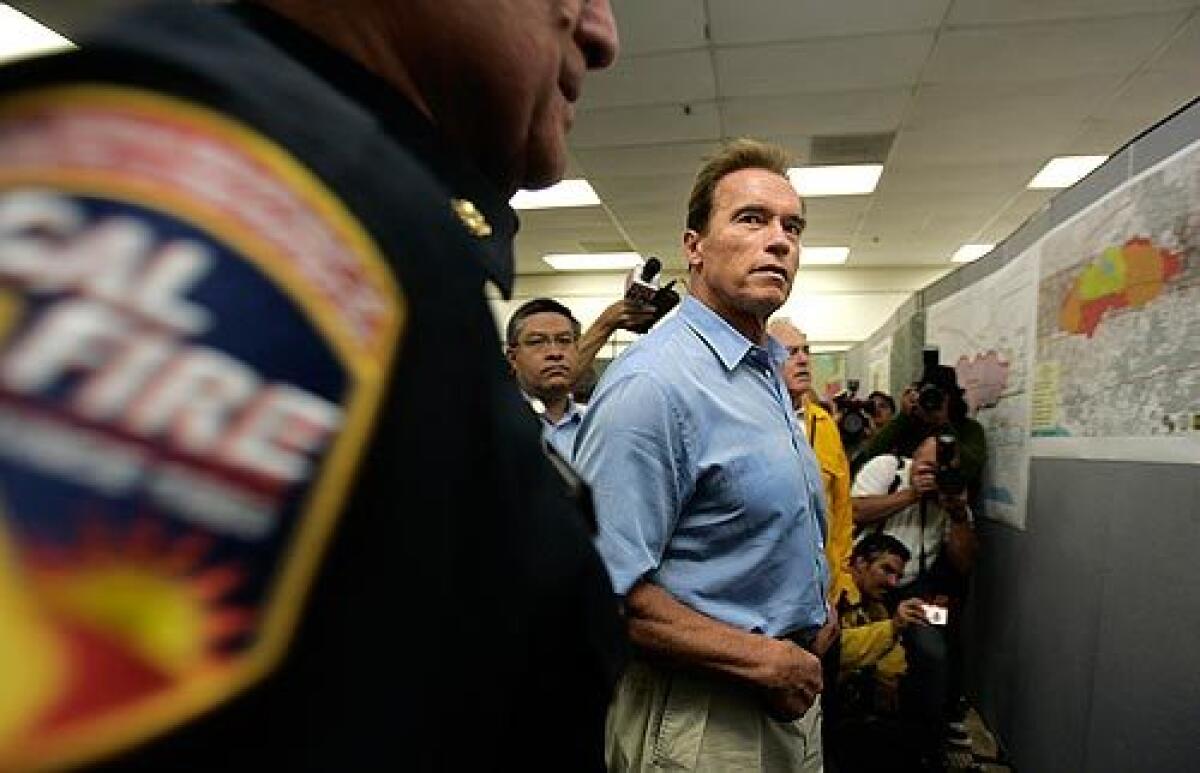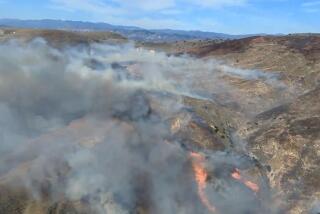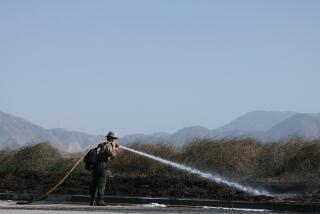‘Critical day’ for growing Goleta fire; Big Sur blaze only 5% contained

GOLETA, Calif. -- Driven overnight by “sundowner” winds that gusted to 50 mph, the Gap fire grew to more than 8,300 acres, but by morning was 24% contained, fire officials said. The blaze destroyed four outbuildings and led to the evacuations of at least 2,663 homes. About 1,400 other homes remain on standby for evacuation, fire officials said.
Firefighters battling more than 300 blazes in the state got bad news Saturday afternoon when the National Weather Service issued a heat warning for coming days. Scorching temperatures are forecast for next week from Santa Barbara to the Inland Empire, with record or near-record highs likely in valleys and foothills.
At the peak of the fire siege that began June 20, some 1,783 fires burned, many ignited by lightning strikes. So far, more than 510,000 acres from Nevada to the Pacific Ocean have burned, destroying 34 homes and 32 outbuildings, fire officials said.
Federal and state authorities, who have more than 20,000 firefighters and other personnel on the lines, said this morning that nearly 11,000 homes are threatened.
In Santa Barbara County, officials lifted mandatory evacuations about 3 p.m. for the area north of Cathedral Oaks Road between Winchester Canyon Road on the west and Fairview Road on the east. Still, Santa Barbara County Sheriff Bill Brown warned residents that conditions could change quickly.
“There’s a very, very good chance we’ll have to do further evacuations,” Brown said, noting of particular concern an area on the eastern fire break north of Cathedral Oaks from San Marcus Road through Highway 154. “Be prepared to move very quickly if evacuation orders come for that area.”
In addition to the Santa Barbara County evacuations, some residents of Monterey and Shasta counties remain under evacuation orders. In Butte, Kern, Mendocino and Plumas counties, as well as additional areas of Monterey County, residents have been warned that they may need to evacuate if fires there grow worse.
Near Big Sur, a stubborn fire that started June 21 remained only 5% contained today, fire officials said. The fire has burned nearly 69,000 acres, shutting down premier tourist destinations and portions of Highway 1. This morning, thick smoke continued to fill the air, and fire officials said they were concerned that the high heat forecast for midweek could worsen conditions for a fire that has proved hard to fight in the difficult terrain.
The Gap fire, which started Tuesday evening, has been fueled by very dry brush that has not burned in more than 50 years. Firefighters there are dealing with steep, rocky terrain up to 3,000 feet high in the Santa Ynez Mountains. The last measurable rain in the area was more than two months ago, officials said.
At a 6 a.m. firefighter briefing, officials said today was crucial to gaining an upper hand on the fire and protecting homes to the east before another night of sundowners started to blow. These winds can create flames more than 15 feet long that cause spot fires up to a quarter of a mile away uphill and a mile away downhill -- one reason for the fire’s overnight growth of about 1,800 acres.
“This is going to be a critical day for us,” said Incident Cmdr. James Smith. “We want to be vigilant, we want to stay persistent and put a good amount of effort in the [east] today . . . so we can seal it up . . . so we can focus on the [west] tomorrow.”
Firefighters today aim to keep the fire south of West Camino Cielo, north of Cathedral Oaks Road, west of Old San Marcos Road and east of Dos Pueblos Canyon. The main focus of the fight today is the east, where the fire is positioned in the San Jose Creek drainage near old San Marcos Road, threatening the communities of Trout Club, Old San Marcos, Camino and Painted Lake, Smith said.
“Our hope is to close this off,” he said.
Gov. Arnold Schwarzenegger spoke this morning at the command post at the Earl Warren Showgrounds in Santa Barbara, describing his daily briefings since the fire siege began two weeks ago.
“I’ve been driving up and down the state of California going to all the various different fires, and you can imagine, this state is very prepared for fire,” Schwarzenegger said. “But when you wake up one morning and have 500 fires across the state, it was a real shock to me . . . only to find the next morning there were 1,000 fires, and the next morning 1,400 fires, and then 1,700 fires igniting over 14 days.”
Schwarzenegger jumped out of a black Suburban at the command center shortly before 10 a.m. dressed in a baby blue button-down shirt, khakis and brown cowboy boots. He was taken back into a conference room in the command center, where he met with fire officials for a 10-minute briefing of the fires statewide and then the Gap fire.
“There were times, honestly, when I thought we’d be losing 100 homes,” Santa Barbara County Fire Chief John Scherrei told the governor.
“This is the No. 1 priority fire in the state right now,” said Candace Gregory, the California Department of Forestry and Fire Protection region chief.
“I know,” Schwarzenegger said. “Believe me, I know.”
Schwarzenegger, who ordered 400 California National Guard troops this week to help the firefighting efforts, said the number of fires had stretched the state thin.
“One never has resources for 1,700 fires. Who has the resources for that?” Schwarzenegger said.
He also took the moment to push his emergency response initiative, which he hopes will pass with the current budget.
“Something is happening, clearly. There’s more need for resources than every before,” Schwarzenegger said. “It’s fire season all year round. . . . It’s a different ballgame, so we have to respond.”
Temperatures today were expected to be in the 80s and 90s, with winds gusting to 20 mph northeast upslope for most of the day. The Santa Ynez Mountains run east to west with north-south slopes, and the fire is primarily at midslope, burning in a warm thermal belt. Therefore the upslope winds, which were not much of a factor Friday because of the cloud cover, are expected to help firefighters as they blow away from Goleta and up the mountains. It is the sundowner winds, pushing downslope, that are the greatest concern.
The evening sundowners, which are forecast from about 7 p.m. to 2 a.m., will turn those winds downslope again, but they are also expected to be weaker than Friday night, said Rich Thompson, the incident meteorologist. The fire is expected to be most problematic on the western and eastern edges, officials said.
Today 1,186 firefighters will be on the line, with at least five helicopters dropping water on the fire, in addition to air tankers as they become available, officials said. At one point Friday, 15 air tankers were dropping retardant on the fire.
“I know we’re at the top of the list because any time an air tanker is available in the state, they call me immediately and we take it immediately,” said Brad Joos, air operations branch director.
The cause of the fire, which started about 5:30 p.m. Tuesday near West Camino Cielo, is still under investigation and has so far cost $2.5 million to fight, said Helen Tarbet, a spokeswoman with Los Padres National Forest. The fire has injured two firefighters, who had minor injuries related to smoke inhalation, Tarbet said.
More problems may be on the way. Weather forecasters in the National Weather Service’s Los Angeles office said today that a high-pressure ridge developing over the central Pacific will track east, squeezing hot air from the interior deserts toward the coast and limiting the cooling marine layer to the beaches.
The warming trend should begin Monday, with temperatures expected to approach or exceed 105 degrees in valleys and foothills by Tuesday. The Antelope Valley could reach temperatures up to 110. Along the coast, temperatures should reach around 90 inland with some foothills up to 100 degrees, weather officials said.
The heat wave is expected to extend at least through Friday. As temperatures begin to level off midweek, moisture from Arizona seasonal monsoons is expected to move into Southern California, bringing sticky humidity and a slight chance of thunderstorms.
Times staff writers Eric Bailey and Mary Engel contributed to this report.
More to Read
Sign up for The Wild
We’ll help you find the best places to hike, bike and run, as well as the perfect silent spots for meditation and yoga.
You may occasionally receive promotional content from the Los Angeles Times.






